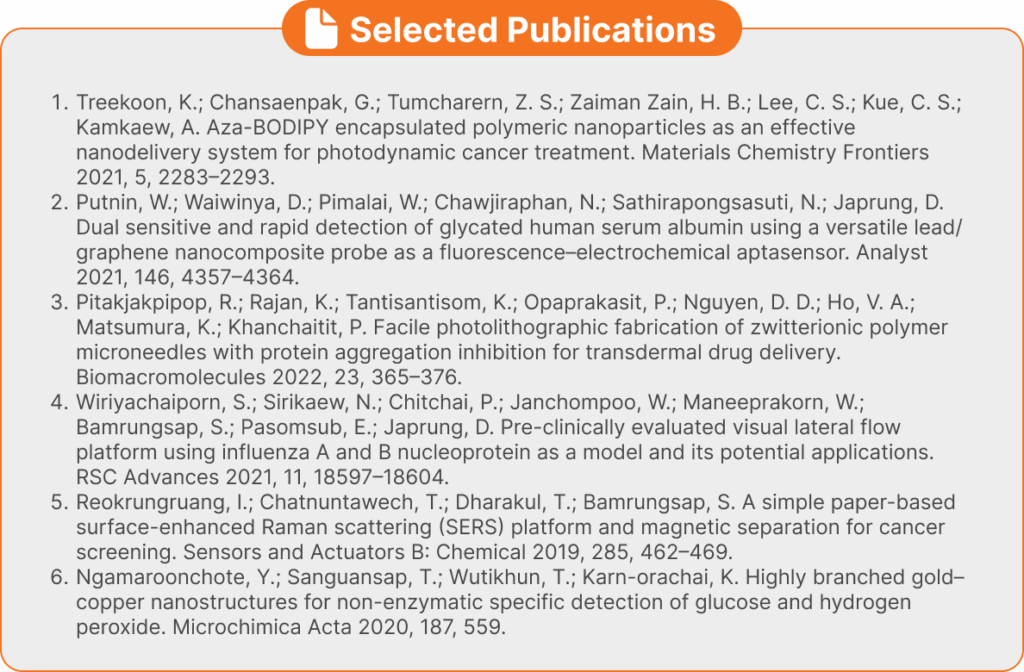
RESPONSIVE MATERIALS AND NANOSENSOR RESEARCH GROUP
The Responsive Materials & Nanosensor Research Group (RMNS) brings together materials design, device engineering, and bio-interface science to create functional, stimuli-responsive nanomaterials and smart indicators that improve quality of life. Our researchers design and synthesize responsive nano-architectures, then integrate them into practical devices capable of detecting and where appropriate remediating in an automatic, cohesive manner.
RMNS works along a clear line of translation: molecularly engineered materials → surface functionalization and targeting → signal generation and amplification → device fabrication and integration. The group’s portfolio spans biomarker detection, diagnostic readouts, minimally invasive micro/nano-interfaces, and responsive indicators for health, food, agriculture, and environmental contexts. By pairing nanoscale control with fit-for-purpose readouts (e.g., fluorescence, colorimetry, surface-enhanced Raman scattering, electrochemistry, nanopore), we aim for high sensitivity and specificity in formats that are practical for laboratories and field deployment alike.

What We Do
- Design & synthesis of stimuli-responsive nanomaterials
Creation of inorganic, organic, and hybrid nanosystems whose optical, electrical, or interfacial properties respond to chemical or physical cues. These materials form the basis for sensors, indicators, and controlled-interaction platforms.
- Targeting & surface chemistry
Engineering of aptamers, peptides, and proteins as targeting elements and bio-conjugation strategies to bind them onto nanoparticle or thin-film surfaces. This surface work underpins selectivity, colloidal stability, and compatibility with complex samples.
- Signal generation & amplification
Use of fluorescence, SERS, colorimetry, SPR, electrochemistry, and nanopore techniques to convert binding events into measurable signals. Nanoparticle-based signal amplification is employed to push detection limits lower while maintaining simple workflows.
- Device fabrication & integration
Building biosensors and diagnostic devices, including lateral-flow platforms and integrated lab-format or portable readers. Focus areas include disease screening and monitoring, food and plant-health testing, and other safety-critical measurements.
- Biological interfaces via micro/nanostructure
Development of micro/nanostructured interfaces such as microneedle patches that enable mass and information transfer with minimal invasiveness, designed to communicate with high precision while avoiding pain receptors and blood-vessel damage.
- Indicators & responsive readouts
Research on visual and instrumented indicators that convey quality or state changes (e.g., in food chains), leveraging dye-doped particles and other responsive chemistries for intuitive communication.
Across these activities, RMNS emphasizes end-to-end integration: the same team that designs a nanomaterial can functionalize it, incorporate it into a device, and evaluate its performance in realistic matrices—accelerating the path from concept to prototype.
Research Themes
1) Diagnostics & Biosensing
RMNS builds high-sensitivity biosensors and diagnostic devices for screening and monitoring of diseases, with expertise in biomarker identification and readout design. The work covers diabetes, kidney disease, cancer, and Alzheimer’s disease, among others using aptamer/peptide/protein targeting and nanoparticle-aided signal amplification to achieve performance in practical formats such as lateral-flow and electrochemical assays.
2) Minimally Invasive Micro/Nano-Interfaces
We develop micro- and nanostructured devices notably nanoneedle and microneedle platforms—that create reciprocal communication channels between the body and the outside world. These interfaces support drug delivery, biosensing, sensory devices, and explorations of next-generation human–machine communication possibilities, while prioritizing accuracy, precision, and user comfort.
3) Responsive Materials & Indicators
RMNS designs stimuli-responsive nanostructures and functional indicators whose properties (color, fluorescence, Raman signature, charge transfer) change in the presence of specific analytes or environmental conditions. Applications include chemical sensing, food pathogen detection, plant-disease diagnostics, and biomedical research, with a focus on clear signals and robust operation.


